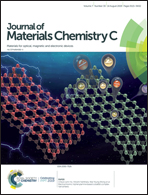An ionic polymer–metal nanocomposite sensor using the direct attachment of an acidic ionic liquid in a polymer blend†
Abstract
Flexible, stable, and reliable sensing materials are required that are independent of the environmental conditions for charging portable devices and touch sensors. Previously, polyelectrolyte based ionic polymer–metal nanocomposites were widely used for actuator and sensor applications due to their flexibility. However, the polyelectrolyte based IPMNC has the limitation of low sensing voltage and mechanical strength, mainly due to the irregular porosity, which hinders its commercial applications. In order to overcome the issue of irregular porosity here, we developed a honeycomb structured ionic polymer–metal nanocomposite (IPMNC) sensor using the direct attachment of an acidic ionic liquid (1-butyl-3-methylimidazolium-hydrogen sulfate) in a poly(vinylidene fluoride-trifluoroethylene-chlorotrifluoroethylene) P(VDF-TrFE-CTFE)/polyvinylpyrrolidone (PVP) blend. Our study reports on the electroless deposition of Pt nanoparticles (NPs) on the ionic liquid embedded P(VDF-TrFE-CTFE) using LiCl as a reducing agent, which is a novel strategy to fabricate IPMNC sensors. Our P(VDF-TrFE-CTFE)/PVP/ionic liquid-based IPMNC sensors generated high sensing voltages up to 380 mV and 300 mV with a bending strain of 0.009 and a stress of 80 MPa, respectively. The honeycomb structure provided uniform porosity in a P(VDF-TrFE-CTFE)/PVP/ionic liquid blend membrane, improving the proton conductivity (3.4 times) and Young's modulus (52 times) of the blend membrane as compared to those of P(VDF-TrFE-CTFE)/PVP/PSSA. The enhanced values of the ion exchange capacity and ion conduction of the P(VDF-TrFE-CTFE)/PVP/ionic liquid blend membrane enhance the electrical and sensing voltage of the P(VDF-TrFE-CTFE)/PVP/ionic liquid-based IPMNC as compared to those of the P(VDF-TrFE-CTFE)/PVP/PSSA, Nafion, and Flemion membrane IPMNCs. The (PVDF-TrFE-CTFE)/PVP ionic liquid-based IPMNC exhibits a stable sensing voltage in dry conditions up to 6000 cycles.



 Please wait while we load your content...
Please wait while we load your content...